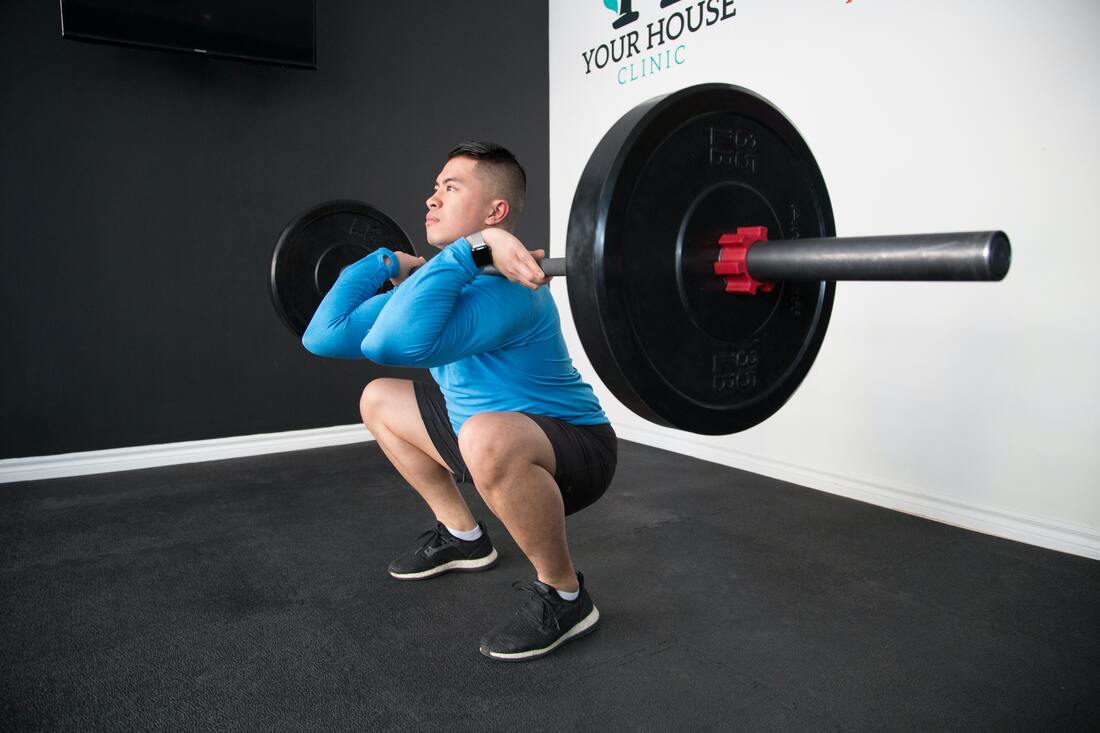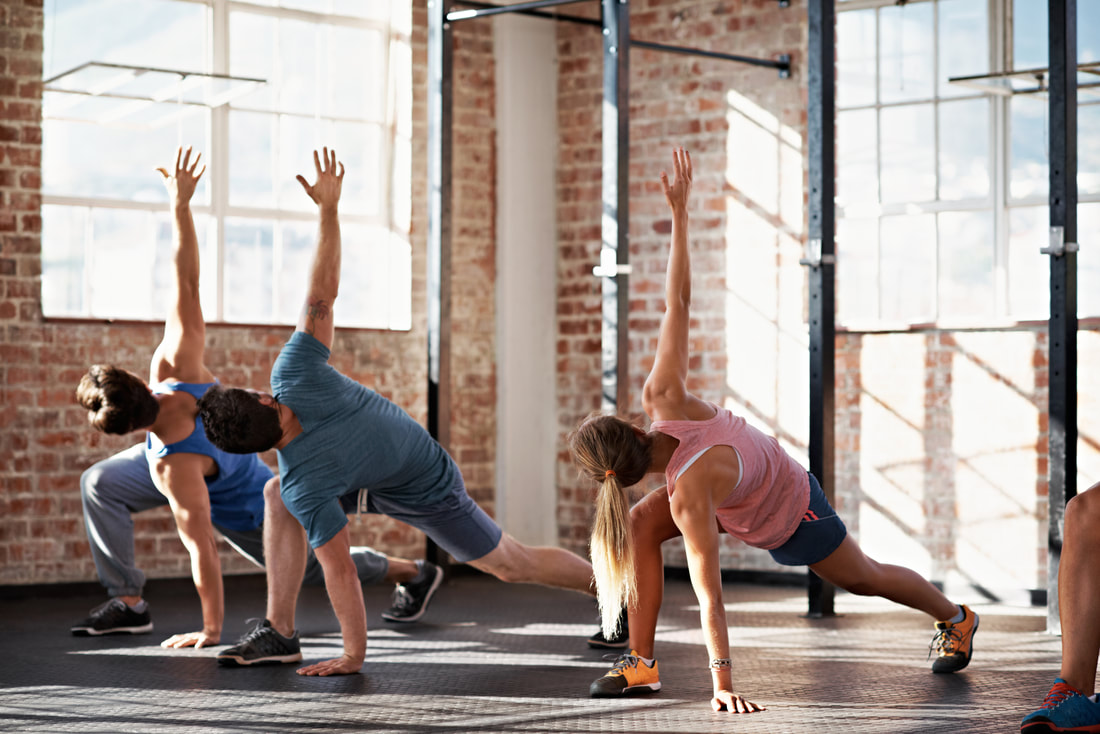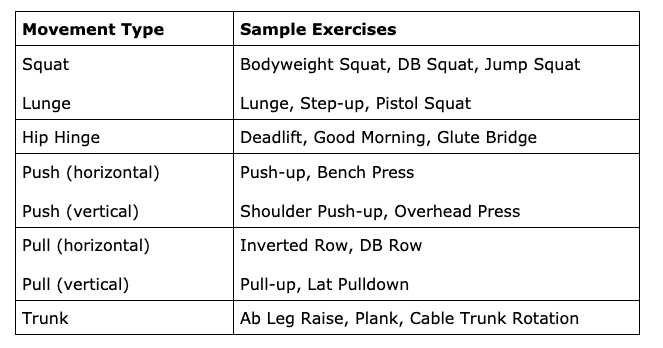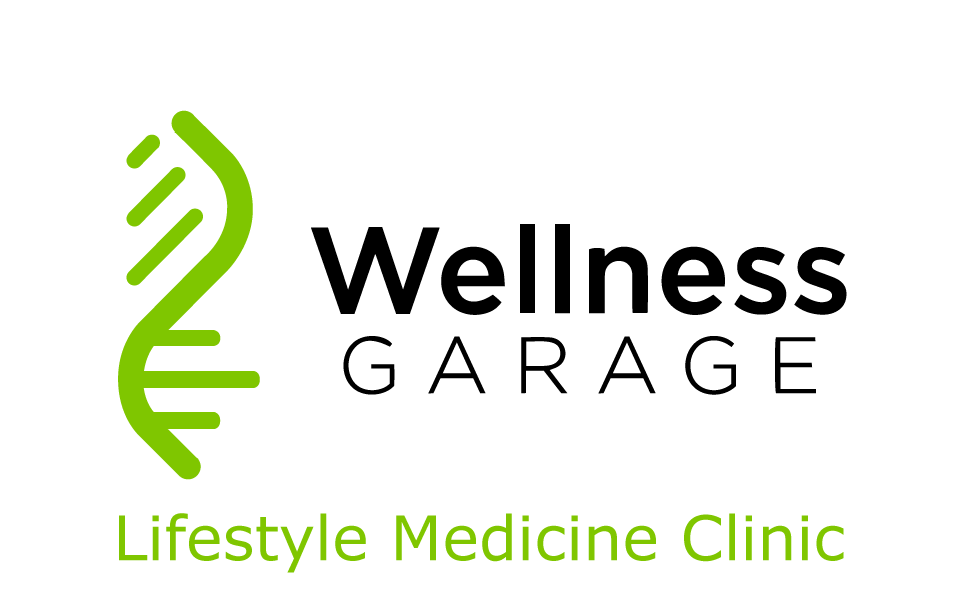|
Our next area to review in the LEVELUp Your Fitness Strategy is Functional Movement. Functional movements are movements based on real-world situational biomechanics. They usually involve multi-planar, multi-joint movements which place a demand on the body's core musculature and innervation.” - Wikipedia In other words, functional movement refers to the ability to move well for the required tasks. What is considered “functional” depends on the task your want to perform. Typically athletic movements like squatting, running, pushing and pulling are all considered functional, but specific movements should be prioritized for different individuals and sports. For example, pulling movements for rock climbing, balance movements for seniors, and agility movements for soccer players. Training to increase functional movement will improve athleticism and the ability to control your body through space. Functional movement training should be incorporated into your week of physical activity and improved or maintained through sports, resistance exercise, balance drills, agility training, and much more. Since everyone needs different areas of focus, your functional movement training should be unique. How do I know if I have good functional movement? Here are some of the factors that contribute to good functional movement:
If you feel that you lack these areas, your functional movement could probably use some work! Aim to identify your weak spots and progressively improve them through practice and training. Identifying your weak points can be challenging, so here are a few simple tests we use at Wellness Garage that can help to assess your functional movement.
These are all movements that you can improve with training. If you feel that you need help assessing and improving your functional movement, seek advice from an exercise specialist. Injuries If you have a recurring or current injury, correctly rehabbing it will be essential to improving and sustaining high-quality movement long-term. Proper warm-ups and prehab strategies can also maximize injury prevention. Are weight machines functional? Although many people consider weight machine training to be “non-functional,” it would be a shame for bodybuilders and other muscle-building athletes to avoid them! Since machines typically do not demand the same level of stability and technique that free weights do, they allow us to push the muscles harder with good form, often targeting muscles in a way that free weights cannot. Machines can also be great for new gym-goers or people with physical limitations. While machines don’t improve athleticism and body coordination to the same degree as free weights and bodyweight exercises, there is a time and a place for them.  Photo by Sergio Pedemonte on Unsplash Functional Resistance Training Working out can be a great way to improve functional movement. Here are the primary movement patterns in resistance training that will improve strength and athleticism while hitting all of the major muscle groups:
Functional Resistance Reference Chart Most comprehensive workout programs designed to increase muscular strength and athleticism should include these fundamental movement patterns. These movements should generally be prioritized and performed before machine and isolation exercises (i.e. bicep curls, leg extensions, pec flyes).
Other Functional Movements Other types of athletic training, such as plyometrics and agility training (i.e. jumps, hops, skips, leaps, bounds, shuttle runs), are also very functional; however, they are more advanced and require a greater focus on technique. Make sure you have a base in strength training and technique before attempting these types of workouts. Plyometric and agility training should always be performed first in the workout before the body becomes fatigued. What if I can’t perform one of these movement patterns? If you have a restriction (mobility, injury, etc.) and cannot perform one of these movement patterns, work around it by hitting the same muscles with alternative exercises. For example, train the shoulder muscles with DB Front Raises and DB Lateral Raises instead of Shoulder Presses. See an exercise specialist if you need help with this. Neuromuscular Training Neuromuscular training to improve balance, stability, coordination, and proprioception (kinesthetic sense) is essential for maintaining athleticism and quality of life. This type of training is critical as we age, as it can improve activities of daily living and prevent falls and other injuries. Specific neuromuscular exercises like balance and agility drills are typically performed at the beginning of a workout (right after the warm-up) while the mind and body are still fresh. Performing at least 60 minutes per week of neuromuscular exercise is most effective in improving athleticism and is typically performed in bouts of at least 20-30 minutes. Some examples of balance and agility drills include:
Stretching Stretching is a great way to improve and maintain the range of motion at a joint and is often a significant area of focus for individuals looking to improve their movement quality. If you have tight muscles or movement inhibited by a lack of flexibility, consistent stretching can correct this issue. Several types of stretching increase movement quality and range of motion Static Stretching
Dynamic Stretching
Ballistic Stretching
PNF Stretching (proprioceptive neuromuscular facilitation)
Foam Rolling (and other manual release techniques)
For most people, static stretching (passive) is the recommended method for safely increasing range of motion long-term. Stretching Guidelines
How long does it take to increase range of motion? While individual results vary, typically, you will see results after four weeks of consistent stretching (2-3 times per week). If you do not see results in this time frame, try increasing your weekly stretching time or speak with an exercise professional. When should I perform my stretching? You can stretch any time of day; however, optimal movement comes by increasing the muscles’ temperature beforehand. Try 3-5 minutes of light aerobic activity or use external heating sources like a hot pad or a warm bath to warm muscle. Don’t do static stretching in your warm-up. Static stretching (roughly >30-45 seconds) immediately before exercise can reduce the ability to generate strength, power, and sports performance, so for this reason, avoid static stretching until after your workout. If you want to increase your movement quality and range of motion without decreasing your performance, try dynamic stretching and foam rolling. These are much better options for your warm-up! Stretching Program We have created a sample general stretching plan for increasing range of motion - click here for the details. Warming Up Warming up increases exercise performance and reduces the risk of injury by circulating blood to the active muscles, preparing the body for specific movements, increasing mobility, and improving muscle activation and proprioception. Here are some different types of warm-ups that everyone should incorporate into their exercise. 1) General Warm-Up A general warm-up improves circulation, increases blood flow to the muscles, moderately raises your heart rate, causes you to sweat slightly, and gets your mind ready to start exercising. General warm-ups usually take about 5-10 minutes and are often performed as light cardio. 2) Dynamic Movement Warm-Up Dynamic movement warm-ups are often the most neglected type of warm-up but are very important. A proper dynamic warm-up typically includes short duration stretches and functional movements that will allow you to feel more limber and stable before exercise. Some dynamic warm-ups are used for injury management and muscle activation as well. Dynamic movement warm-ups can take anywhere between 5 and 20 minutes, depending on how well you are moving that day. Generally speaking, if your movements feel restricted and less stable than usual, prolong your warm-up. Examples of dynamic warm-ups are leg swings, inchworms, lunge and twists, and hops. 3) Exercise-Specific Warm-Up Don’t work too hard, too soon! Working up to your maximum output for the day is essential for injury prevention and performance. Slowly working up in weight or speed allows your muscles and nervous system to start acclimating to the stimulus. The first thing to do in an exercise-specific warm-up is to make sure you groove the movement. Grooving a movement means practicing it until it feels proficient enough to start increasing intensity (i.e. warming up with the bar before squats, light jogging before sprinting, etc.). Once the movement is grooved, spend a few minutes working up to your full intensity for the day. Warm-up Program We have created a sample warm-up you can use before workouts - click here for the details. Need help starting resistance training? Get a personalized fitness plan to help you get started, progress or improve your enjoyment of physical activity The TARGET Fitness Plan gives you expert advice to transform your exercise habits - whether you are getting started or want to improve your current program. Our exercise physiologist will assess what you are currently doing and provide you with a personalized fitness plan based on the LEVEL Up Your Fitness Strategy. Next Week: Progressing Aerobic Fitness |
AuthorDr. Brendan Byrne Categories
All
|



 RSS Feed
RSS Feed
